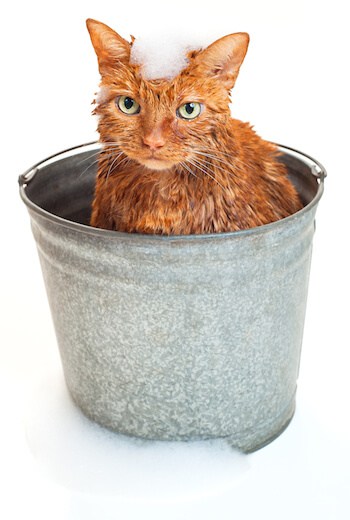30 November, 2017
Cats do clean themselves, but sometimes that’s not enough. We know the lovely smell of their clean paws, but we also know the faint smell of cat urine that their fur can have. And sometimes they just get themselves into messy situations, which require immediate washing.
If your cat needs a bath, but you're scared of being clawed to death, follow these steps to introduce your cat slowly to being washed. It’s a good idea to train your cat and be ready before you find him covered in bike grease.
1. You should start training your cat as a kitten. If that ship has sailed don’t worry, you can still train your cat, but you might have to be more patient. With small steps and a lot of patience, you will eventually be able to bathe your cat without injuries to either party.
2. First, let your cat get accustomed to the sink or tub by letting him sit there and play with his favorite toys. This way he won’t think of the sink or tub as a scary palace, but as a place for something fun. You could get some new and exciting toys just for bathtime.
3. When you feel your cat is comfortable with the sink or tub, add an inch of water. Encourage your cat to stay in the water by sitting beside him and playing. Never push your cat out of its comfort zone or try to submerge him. Making slow progress one step at a time is better that traumatizing your cat and making him never want to bathe again.

4. Prepare for the bath by taking out everything you need and closing the bathroom door. You don’t want a frantic wet cat running around the house. Having everything prepared means you can stay calm and relaxed. You need at least cat-friendly shampoo, brush, towels and a pitcher for rinsing.
5. Comb or brush your cat before the bath to remove dust and to brush out tangles. Especially if you have a long-haired cat, the tangles can be a nightmare to comb out once the fur is wet. Brushing him with gentle strokes will also calm your cat down before it’s time to get wet.
6. You should also trim the claws to avoid getting mauled but do this a few days ahead so your cat won’t be agitated right before bathtime. You should wear protective clothing while bathing your cat to minimize the damage in case your cat decides to claw its way up from the tub.

7. Remember that it’s always easier to bathe a tired cat. Play around with your cat to tire him out and then take him to the bath. When he’s tired, he won’t put up a fight. Never wake up a cat for a bath though. If he is napping, let him rest and try again later on.
8. Get the right shampoo and under no circumstances use your own. Regular human shampoo might irritate your cat's eyes and skin making the bath an uncomfortable experience. Human skins have a different pH, so using your shampoo will dry out your cat's fur.
9. If you have a slippery tub, place a rubber mat on the bottom to make it safe. This way your cat won’t slip and hurt himself if he gets panicked.
10. When bathing your cat, remain calm. Your cat will sense if you are stressed out, and he will interpret the situation to be threatening. Talk to your cat in a quiet assuring voice. Remember to keep your voice cheery and light, and never yell at him no matter what happens. Getting angry will only send the message that bathing is not fun and should be avoided. The tenser you are, the more agitated your cat will be.
11. Add lukewarm water slowly and don’t expect to give your cat a full bath the first time. Use gentle strokes and start by washing the feet and then gently working your way up keeping an eye on how your cat reacts. Don’t push it too far, and slowly make some progress one bath at a time.
12. Rinse the shampoo carefully and wash the face gently with a wet washcloth. Make sure you don’t get water and soap into the ears, eyes, and nose, as that might cause irritation or infections. If your cat doesn’t mind it, you can use small cotton balls in his ears to avoid water getting in.

13. Watch your cat for signs of distress. If you feel your cat is panicked or feels too uncomfortable, stop what you're doing and try again next time. Signs of distress include breathing heavily, hissing, growling and meowing. Remember that the bath should be a happy event and not something that makes you both anxious.
14. After the bath gently rub and blot your cat's coat until it’s dry. Use gentle massaging movements and discontinue if your cat doesn’t like to be touched with a towel. You can also try drying your cat with a blow dryer if he isn’t scared of loud noises. Make sure you set the dryer on warm and not hot.
15. Reward your cat after a bath with his favorite treats to enforce the positive association. Praise him for being a good cat, even if you only managed to make a little progress. This will make him want to bathe again.
There you go!
With these vet-approved instructions, you should be able to train your cat to accept baths. The key is to remain calm but firm to assure your cat the situation is by no means scary or something to be terrified about. Now get that smelly cat cleaned up!

